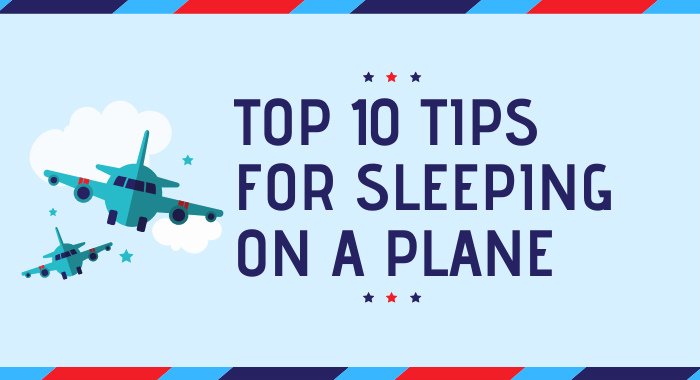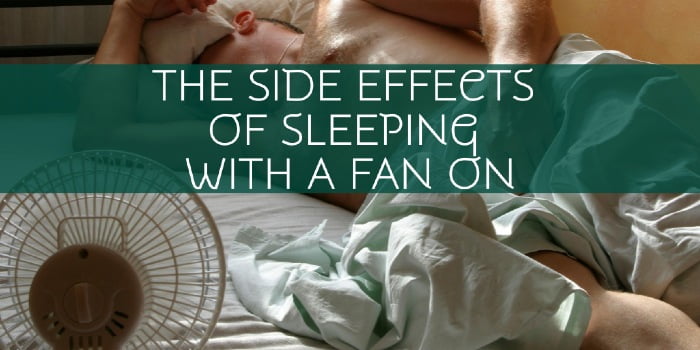Like most of you, I adore travelling. But there’s one thing that thousands of us out there have in common, it’s that you can’t sleep on planes.
Some people have it easy. I’ve watched my dad fall asleep before other passengers have had a chance to get on the plane. Yet, I spend every journey wide awaked and wishing I could join the others.
And it’s not just to pass the time either. Sleep is essential for helping you feel refreshed and revitalised, ready for whatever your chosen destination has to throw at you. It’s hard to enjoy that and take in the sights when you can’t keep your eyes open when you land.
But we’re here to help combat that, with a list of tips and advice to help you sleep soundlessly on a plane.
1. Choose the best seats for sleep
If you can pick your own seat on the plane, you’d stumbled across the golden opportunity for sleep.
If you have the budget, fly business class.
This is because you’ll be gifted more space and comfort – making it easier to fall asleep. But if you don’t have the budget or option for this, you need to pick your economy seats well.
Here are a few tips on selecting the best seats on the plane:
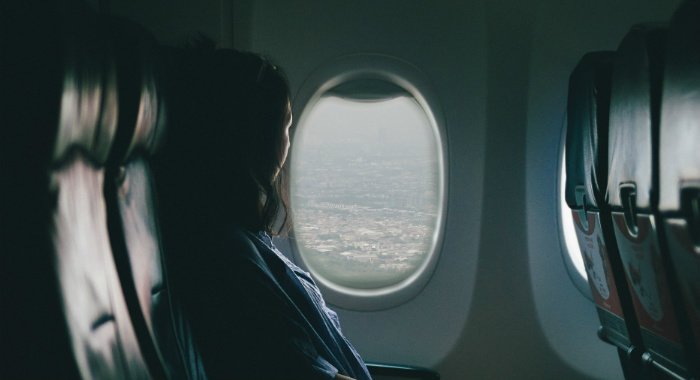
- Always go for the window seat. This will prevent the passengers next to you from awkwardly waking you up when they need to go to the bathroom or move around. In addition, you’ll also get an extra wall to lean against, which will help some people get comfortable. When it’s time for some shuteye, you’ll also be in control of the window blind as well.
- Avoid exit row seats. Sure, the free legroom looks tempting. But a lot of exit row seats on planes don’t actually recline in case of emergency. So, that means you’re stuck with a dreadfully uncomfortable upright seat for hours on end. No thank you.
- Bulkhead seats should be avoided. On some aeroplanes, the armrests on bulkhead seats can’t be raised. Like exit row seats, this will really limit the positions you can get comfortable in. In addition, bulkhead seats are often a popular choice for families travelling with young children – so if you don’t want crying to keep you awake, we’d suggest sitting far away.
- The last row is a no go. Depending on the layout of the plane, these seats might not be able to recline, giving you the same issues as exit seats. But even if they do recline, they’re often right next to the lavatories. So, you’ll have to deal with the door banging open and shut, people waiting around in a queue or even offensive odours. Yuck.
Once your seat is out of the way, it’s time to move onto tip number 2 and get as comfortable as you can inside of it.
2. Get comfortable
You can’t sleep if you’re not comfortable. This isn’t a revelation, it’s a basic fact.
Now, aeroplanes are destined to fly people from one destination to another. Not to give you a good night’s sleep. So comfort can be a little hard to achieve.
But there are some things you can do to make it a little better, including reclining your seats and raising your armrests. Your goal: find a position that makes you as flat as possible to help eases any pressure on your muscles and neck.
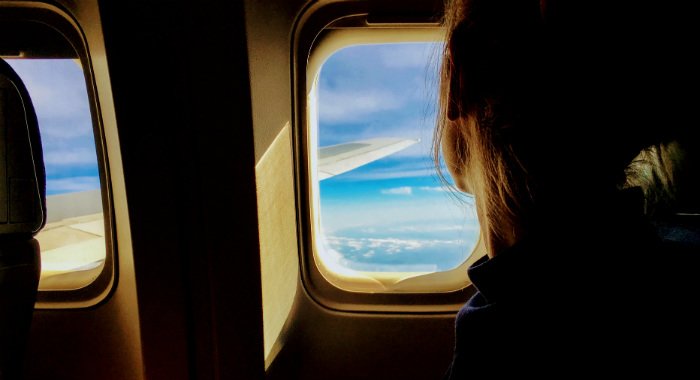
Sleeping sat upright is not good for your muscles or your circulation. And if you’re at risk of DVT (which we’ll cover later), you need to make sure you do everything you can to improve your circulation while on the flight.
The more horizontal you can be, the better.
3. Skip the caffeine
If you want to sleep through your flight, avoid that pre-boarding coffee trip.
Skipping caffeine is an important step to improving the quality of your sleep. This is because caffeine interferes with your natural sleep cycle, by blocking a chemical called adenosine. This chemical is what makes you feel tired and send the signal for your body to start producing sleep hormones.
If you have caffeine, you won’t feel tired. Which means you’re not getting to sleep on that plane.
4. Decline the alcohol
Sorry party holidayers, but alcohol is not your friend if you want to sleep on a plane.
This is because alcohol has a habit of distributing your sleep cycle by limiting your production of melatonin.
In addition, alcohol can make you very dehydrated. This is particularly bad news on planes, which naturally dehydrate you anyway. It happens because the air is brought in form the high altitudes outside the plane, which has less moisture than the air you’re used to.
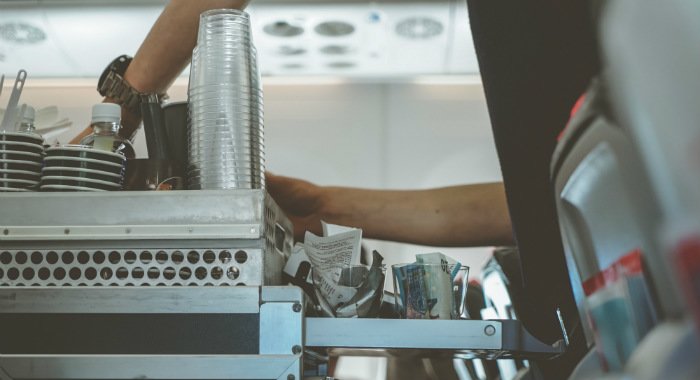
If you sleep when dehydrated you’ll wake up earlier, feeling groggy and in desperate need for a drink. For the best plane sleep, stay away from alcohol and caffeine and drink plenty of water.
5. Turn your screens off
Looking at screens makes it harder to fall asleep. There’s countless evidence that supports this and yet we carry on thinking that more stimulation is a great idea before sleeping.
It’s not.
The last thing you need before you go to sleep is to give yourself new things to think about. What you need is to let go of your thoughts of the day and clear your mind. You can’t do that by catching up on the latest films or TV that you’ve missed.
You’ll be told to switch off all electronic devices before you fly. Do yourself a favour and keep them off to while you prepare your body for sleep.
6. Prepare your environment for sleep
A cleaner environment will help limit distractions and make it easier for your mind to switch off.
It’s hard to be distraction-free if you have two full-sized carry-ons and various items stuck under your feet. The flight attendants won’t be too happy about it either and will more than likely interrupt you to see if your baggage can fit elsewhere.
If you’re going to have a lot of carry-ons, pack them in a smart way. Keep the one with the lightest and essential items that you might need with you. Then, look the rest away in the overhead compartments and forget about them. It’s never going to be a perfect environment on a plane, but you can get it close enough to drift off.
7. Prepare and pack well
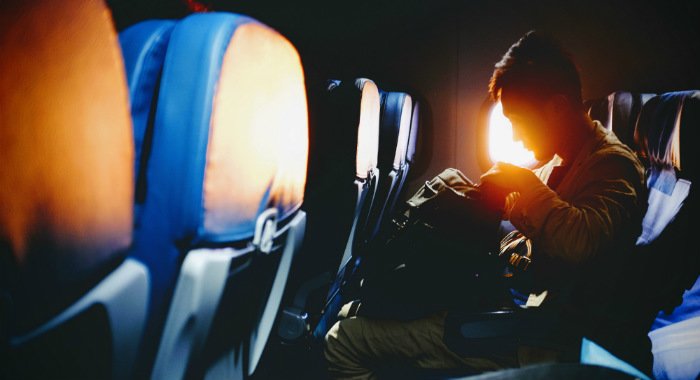
There are 3 must-have items that people swear by for a peaceful sleep on a plane. These are:
Ear defenders
It’s almost impossible to sleep in a noisy environment. To help keep it quieter, pack a pair of ear defenders to help keep some of the noise out.
If you don’t have ear defenders, try some noise-cancelling headphones and downloading ambient music to block out the humdrum of the plane. There are some apps that are perfect for this, including Headspace which has an entire sleep library to help you nod off.
An eye mask
Once the noise is sorted, it’s time to block out the light and create yourself a dark environment.
This is hard on a plane, particularly if you’re flying through the day. If you’ve got a window seat, you can close the blinds on your window, but that’s it. You can’t do anything about anyone else’s windows or the lights on the plane.
But if you pack an eye mask, you don’t have to. It will block out the light for you, creating your own personal darkroom. If you’re in a pinch, some spare clothing like a scarf can serve as a makeshift mask. You just have to deal with the problem of it falling off mid-snooze.
A pillow
This is arguably the most important item to pack for any journey as it gives your neck support and prevents it from hurting when you wake up. In addition, they also help you get more comfortable and find a better position to sleep in.
Sleep pillows often get a bad reputation. But that’s because there’s no one pillow that suits everyone. The stereotypical design you might be used to isn’t the only option out there.
There are pillows that are specifically designed for side sleepers, back sleepers and stomach sleepers. You’ve just got to find the one that matches the way you sleep.
If you’re in doubt, you can always use an adaptable pillow. These are often shaped like a snake and can be positioned any way you need them to be, making sure you’re comfortable no matter where you are.
8. Dress comfortably
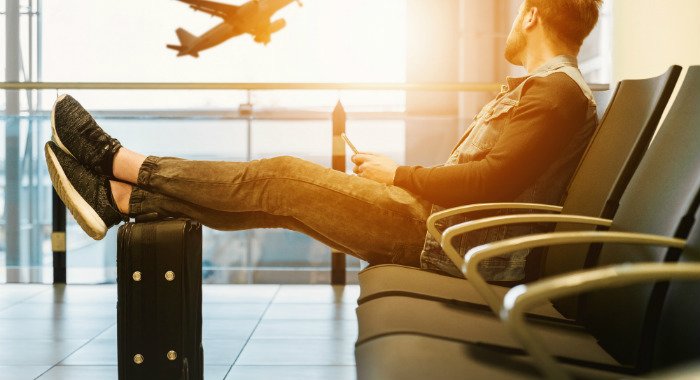
You cannot sleep in tight, restricting clothing. This is something we’ve covered before, but the TL;DR is that tight clothing inhibits your melatonin production, making it harder to fall asleep.
Wear loose clothing and dress in layers. That way you can easily put on, or take off, a layer depending on if it’s too hot or cold.
There’s one exception to this and that’s socks. If possible, you should wear compression socks to limit your risk of DVT, which we’ll cover in more detail below.
9. Make sure you won’t be disturbed
There’s nothing worse than just drifting off to sleep only to have someone wake you up.
When you’re on a plane, this sometimes can’t be avoided. But there are certain things you can do to make sure you’re disturbed as little as possible.
The first thing to do? Tell your flight attendant and the people next to you that you’re going to sleep. This will stop them disturbing you when the drinks cart comes around and will hopefully make any Chatty Cathys out there think twice before trying to talk to you.
Secondly, if you’re using a blanket, buckle your seatbelt over the top of it. If you keep your seatbelt visible at all times, it will stop flight attendants from having to wake you up to see if you’re still buckled or not.
10. Fly red-eye when possible.
Red-eye flights are ones that go through the night – making them ideal for those that want to sleep.
These flights are also good for helping fight off jetlag and keeping your circadian rhythm in tip-top condition as you’ll be sleeping through the night and awake during the day.
Is it bad to sleep on a plane?
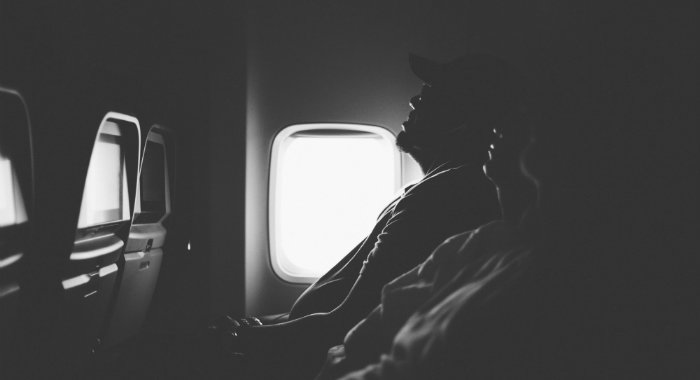
The short answer: no. It’s not bad to sleep on a plane.
The long answer is a little more complicated than that. The sleep itself isn’t bad, but there are a couple of instances where it can be bad to sleep on a plane for a few very specific reasons.
The first of which is how you fall asleep. If you’re sat in an uncomfortable position with your neck bent at an awkward angle, then you’re going to wake up with a lot of muscle pain and uncomfortableness.
Depending on your flight path and times, sleeping can also make your jet lag worse. For example, if you’re flying from California to London and are due to land at 10 pm, the last thing you want to do is sleep on the plane journey. This will just make your jet lag worse by making your body think it’s time to wake up when you land – when really, you should be ready to hit the hay.
It’s also not recommended that you fall asleep during take-off and landing. This is because, during these two times, the pressure on the plane changes dramatically. It’s what makes your ears ‘pop’.
If you’re asleep, you can’t do anything to actively combat and ease this pressure on your ears. This could leave your ears to stay blocked, increasing your potential risks for dizziness, ear infections, eardrum damage, nosebleeds and even hearing loss in extreme cases. If you’re a frequent flier, this is absolutely paramount to keep your health at its best.
Will sleeping on a plane increase my risk of DVT?
For those unaware, DVT stands for Deep Vein Thrombosis. It’s where you get a blood clot in your vein, usually your legs, which can be medical emergencies.
The risk of DVT is increased on long journeys, such as planes, as you’re staying in one position for several hours at a time. If you’re not sleeping, it’s recommended that you get up and walk around every half an hour or so to keep the blood flowing. But you can’t do that while you’re asleep, which could increase your risk of DVT.
If you’re planning on sleeping through a flight, you might want to invest in a pair of compression socks. These are knee-length socks that put gentle pressure on your legs and ankles, helping to increase your blood flow.
Get ready for take-off
If you want to get the best sleep on a plane, the best advice is to prepare in advance.
That means picking the best seats and packing all of the essentials that you need to get comfortable, block off the sounds of the plane and enjoy your much-needed shut-eye.
If you’re planning on sleeping for a long time, it’s also recommended to invest in a pair of compression socks to help limit your risk of DVT while remaining in one position for hours on end.
Following these tips, you should be ready to take-off straight into the land of dreams.
